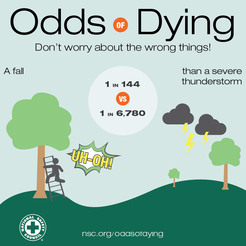Mark Twain is credited with saying, "I have known a great many troubles, but most of them never happened." I imagine many Americans can relate. When we really think about it, most of the things we worry about or fear do not end up materializing.
This begs the question: If our biggest fears - plane crashes, shark attacks, earthquakes or other headline-grabbing catastrophic events - are unlikely to affect us, what should we actually worry about? The annual 'Odds of Dying' list from the National Safety Council can help identify incidents that are most likely to jeopardize our safety.
Millions of Americans get in cars every day without a second thought. Millions also board airplanes, and some of them do so with a great deal of anxiety even though airplanes do not crash often. Car crashes, however, are quite common. They are the second leading cause of unintentional injury death in the U.S., killing more than 35,000 people each year. By contrast, only 41 people were killed in commercial airplane crashes* in 2011.
When NSC calculates the 'Odds of Dying', it takes into account the prevalence of incidents. The lifetime odds of dying in a plane crash - a tragic but infrequent event - are 1 in 96,566. However, the lifetime odds of dying in a car crash should cause anxiety: 1 in 112.
If those odds were surprising, read on, because knowledge is power. Turns out, when it comes to many everyday activities, the odds are not really in our favor.
We probably don't think twice about tripping over our shoelaces, catching the edge of a rug or stumbling over a crack in the sidewalk. But what may seem like a simple misstep can have serious consequences, particularly for older adults. Falls are the third leading cause of unintentional injury death, accounting for 27,500 deaths each year.
The lifetime odds of dying from a slip, trip and fall? One in 144.
Many Americans do not hesitate to take opioid painkillers when prescribed by their doctor. Drug overdoses are still widely believed to happen in dark alleys - not in suburban homes. But nearly 15,000 overdose deaths each year involve opioid painkillers, which means the most fatally abused drug today is legal and sitting in the medicine cabinet.
The lifetime odds of dying from a prescription painkiller overdose are 1 in 234.
Making safe decisions can reduce your odds of dying
The 'Odds of Dying' list is not a crystal ball. Because it is made up of population-wide statistical averages, it does not necessarily determine how any one specific person will die. Making safe decisions can reduce the risks of dying from a preventable incident. For example, wearing a seat belt, turning off cell phones and designating a sober driver can greatly reduce the risk of a fatal car crash. Avoiding prescription painkillers in favor of safer alternatives can reduce the likelihood of a fatal overdose and a devastating addiction. Wiping up spills, installing handrails on stairways and paying attention to where you are walking will help reduce the risk of a fatal fall.
Prevention is the best medicine. When we start worrying about the most likely threats to our safety instead of the headline grabbing ones, we can make positive changes to defy the odds.
• Deborah A.P. Hersman is president and CEO of the National Safety Council.
* NSC Injury Facts 2015 defines "commercial airplane crashes" as those involving large airlines, commuter airlines and on-demand air taxis.


